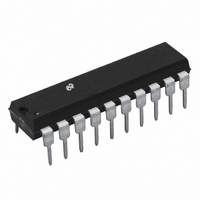COP8SAA720N8 National Semiconductor, COP8SAA720N8 Datasheet - Page 29

COP8SAA720N8
Manufacturer Part Number
COP8SAA720N8
Description
IC MCU OTP 8BIT 1K 20DIP
Manufacturer
National Semiconductor
Series
COP8™ 8SAr
Datasheet
1.COP8-PGMA-28CSP.pdf
(60 pages)
Specifications of COP8SAA720N8
Core Processor
COP8
Core Size
8-Bit
Speed
10MHz
Connectivity
Microwire/Plus (SPI)
Peripherals
POR, PWM, WDT
Number Of I /o
16
Program Memory Size
1KB (1K x 8)
Program Memory Type
OTP
Ram Size
64 x 8
Voltage - Supply (vcc/vdd)
2.7 V ~ 5.5 V
Oscillator Type
Internal
Operating Temperature
-40°C ~ 85°C
Package / Case
20-DIP (0.300", 7.62mm)
Lead Free Status / RoHS Status
Contains lead / RoHS non-compliant
Eeprom Size
-
Data Converters
-
Other names
*COP8SAA720N8
Available stocks
Company
Part Number
Manufacturer
Quantity
Price
Company:
Part Number:
COP8SAA720N8
Manufacturer:
NS
Quantity:
6 231
Note 20: y is a variable which represents the VIS block. VIS and the vector table must be located in the same 256-byte block except if VIS is located at the last
address of a block. In this case, the table must be in the next block.
9.0 Interrupts
ample, if the Software Trap routine is located at 0310 Hex,
then the vector location 0yFE and -0yFF should contain the
data 03 and 10 Hex, respectively. When a Software Trap
interrupt occurs and the VIS instruction is executed, the
program jumps to the address specified in the vector table.
The interrupt sources in the vector table are listed in order of
rank, from highest to lowest priority. If two or more enabled
and pending interrupts are detected at the same time, the
one with the highest priority is serviced first. Upon return
from the interrupt service routine, the next highest-level
pending interrupt is serviced.
If the VIS instruction is executed, but no interrupts are en-
abled and pending, the lowest-priority interrupt vector is
used, and a jump is made to the corresponding address in
the vector table. This is an unusual occurrence, and may be
the result of an error. It can legitimately result from a change
in the enable bits or pending flags prior to the execution of
the VIS instruction, such as executing a single cycle instruc-
tion which clears an enable flag at the same time that the
pending flag is set. It can also result, however, from inad-
vertent execution of the VIS command outside of the context
of an interrupt.
The default VIS interrupt vector can be useful for applica-
tions in which time critical interrupts can occur during the
servicing of another interrupt. Rather than restoring the pro-
(1) Highest
(2)
(3)
(4)
(5)
(6)
(7)
(8)
(9)
(10)
(11)
(12)
(13)
(14)
(15)
(16) Lowest
Arbitration
Ranking
(Continued)
Software
Reserved
External
Timer T0
Timer T1
Timer T1
MICROWIRE/PLUS
Reserved
Reserved
Reserved
Reserved
Reserved
Reserved
Reserved
Port L/Wakeup
Default
Source
TABLE 5. Interrupt Vector Table
INTR Instruction
Future
G0
Underflow
T1A/Underflow
T1B
BUSY Low
Future
Future
Future
Future
Future
Future
Future
Port L Edge
VIS Instruction
Execution without any interrupts
Description
29
gram context (A, B, X, etc.) and executing the RETI instruc-
tion, an interrupt service routine can be terminated by return-
ing to the VIS instruction. In this case, interrupts will be
serviced in turn until no further interrupts are pending and
the default VIS routine is started. After testing the GIE bit to
ensure that execution is not erroneous, the routine should
restore the program context and execute the RETI to return
to the interrupted program.
This technique can save up to fifty instruction cycles (t
more, (50 µs at 10 MHz oscillator) of latency for pending
interrupts with a penalty of fewer than ten instruction cycles
if no further interrupts are pending.
To ensure reliable operation, the user should always use the
VIS instruction to determine the source of an interrupt. Al-
though it is possible to poll the pending bits to detect the
source of an interrupt, this practice is not recommended. The
use of polling allows the standard arbitration ranking to be
altered, but the reliability of the interrupt system is compro-
mised. The polling routine must individually test the enable
and pending bits of each maskable interrupt. If a Software
Trap interrupt should occur, it will be serviced last, even
though it should have the highest priority. Under certain
conditions, a Software Trap could be triggered but not ser-
viced, resulting in an inadvertent “locking out” of all
maskable interrupts by the Software Trap pending flag.
Problems such as this can be avoided by using VIS
instruction.
0yFE–0yFF
0yFC–0yFD
0yFA–0yFB
0yF8–0yF9
0yF6–0yF7
0yF4–0yF5
0yF2–0yF3
0yF0–0yF1
0yEE–0yEF
0yEC–0yED
0yEA–0yEB
0yE8–0yE9
0yE6–0yE7
0yE4–0yE5
0yE2–0yE3
0yE0–0yE1
Vector (Note 20)
(Hi-Low Byte)
Address
www.national.com
c
), or











